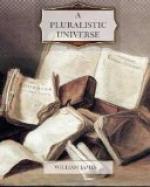Superficially looked at, this seems just like the combination of H_2 and O into water, but looked at more closely, the analogy halts badly. When a chemist tells us that two atoms of hydrogen and one of oxygen combine themselves of their own accord into the new compound substance ‘water,’ he knows (if he believes in the mechanical view of nature) that this is only an elliptical statement for a more complex fact. That fact is that when H_2 and O, instead of keeping far apart, get into closer quarters, say into the position H-O-H, they affect surrounding bodies differently: they now wet our skin, dissolve sugar, put out fire, etc., which they didn’t in their former positions. ‘Water’ is but our name for what acts thus peculiarly. But if the skin, sugar, and fire were absent, no witness would speak of water at all. He would still talk of the H and O distributively, merely noting that they acted now in the new position H-O-H.
In the older psychologies the soul or self took the place of the sugar, fire, or skin. The lower feelings produced effects on it, and their apparent compounds were only its reactions. As you tickle a man’s face with a feather, and he laughs, so when you tickle his intellectual principle with a retinal feeling, say, and a muscular feeling at once, it laughs responsively by its category of ‘space,’ but it would be false to treat the space as simply made of those simpler feelings. It is rather a new and unique psychic creation which their combined action on the mind is able to evoke.
I found myself obliged, in discussing the mind-dust theory, to urge this last alternative view. The so-called mental compounds are simple psychic reactions of a higher type. The form itself of them, I said, is something new. We can’t say that awareness of the alphabet as such is nothing more than twenty-six awarenesses, each of a separate letter; for those are twenty-six distinct awarenesses, of single letters without others, while their so-called sum is one awareness, of every letter with its comrades. There is thus something new in the collective consciousness.




